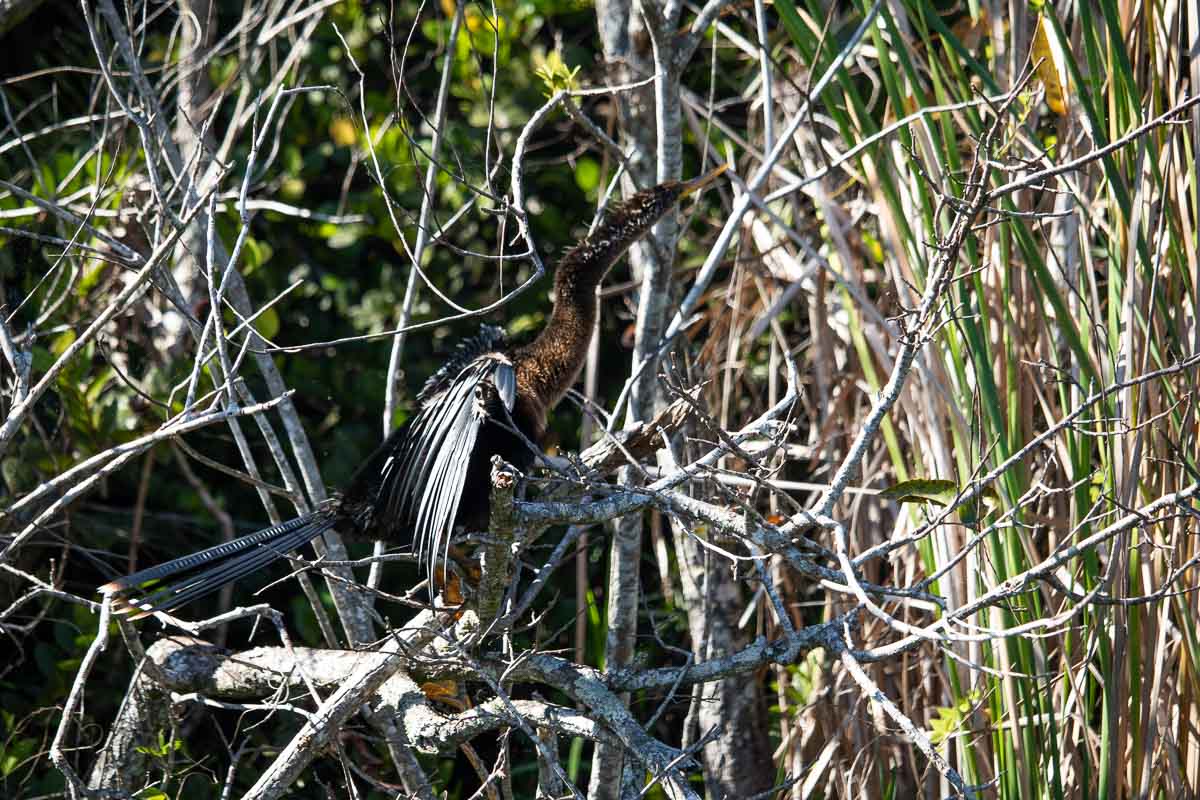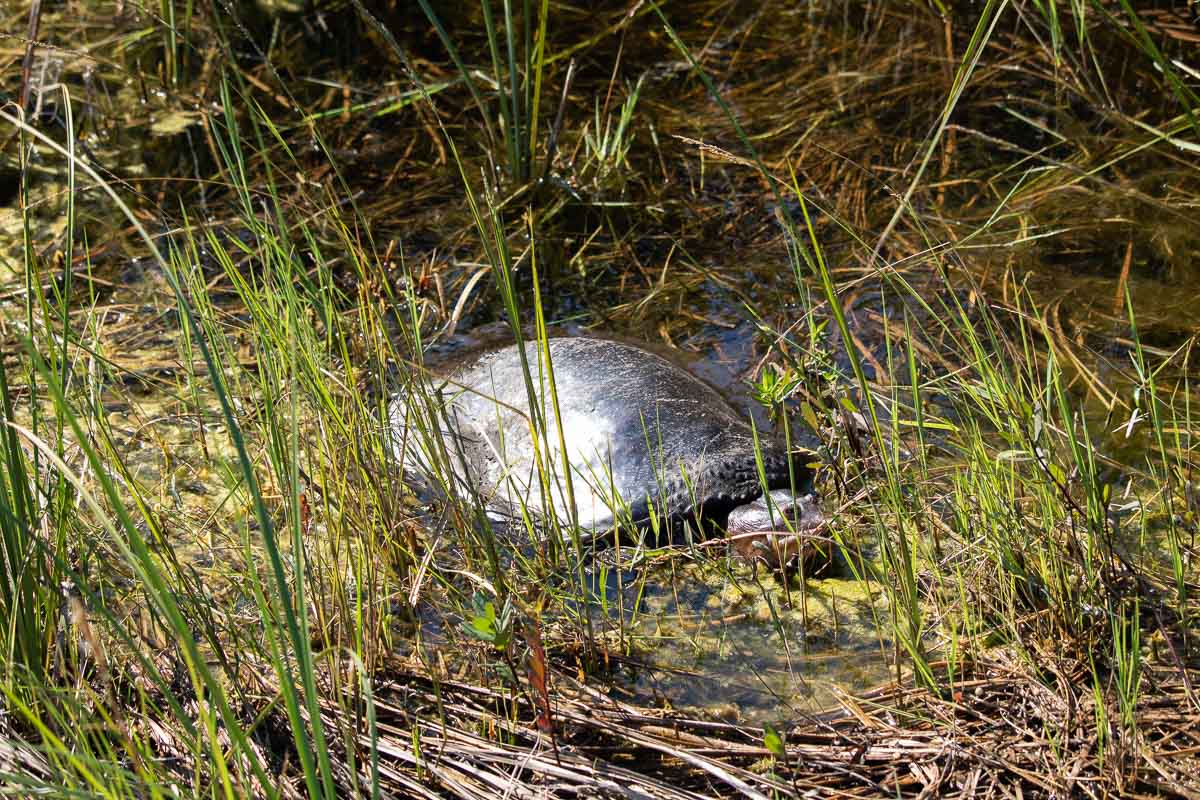Thanks to its almost perfectly flat topography, Everglades National Park allows visitors to easily explore its various habitats on scenic bike rides.
In this post, I’ll tell you all about biking in Everglades National Park and, specifically, the top three best bike trails in the Everglades.
As one of the largest U.S. national parks, this sprawling region in South Florida is home to vast sawgrass marshes, mangroves, hardwood hammocks, cypress swamps, pine forests, and many thousands of islands. And you can explore several of these distinct habitats on a few wonderful Everglades bike trails.
Biking in Everglades National Park is an amazing way to spend some time in the park, which, thanks to the absence of any elevation gain whatsoever, is a surprisingly enjoyable experience.
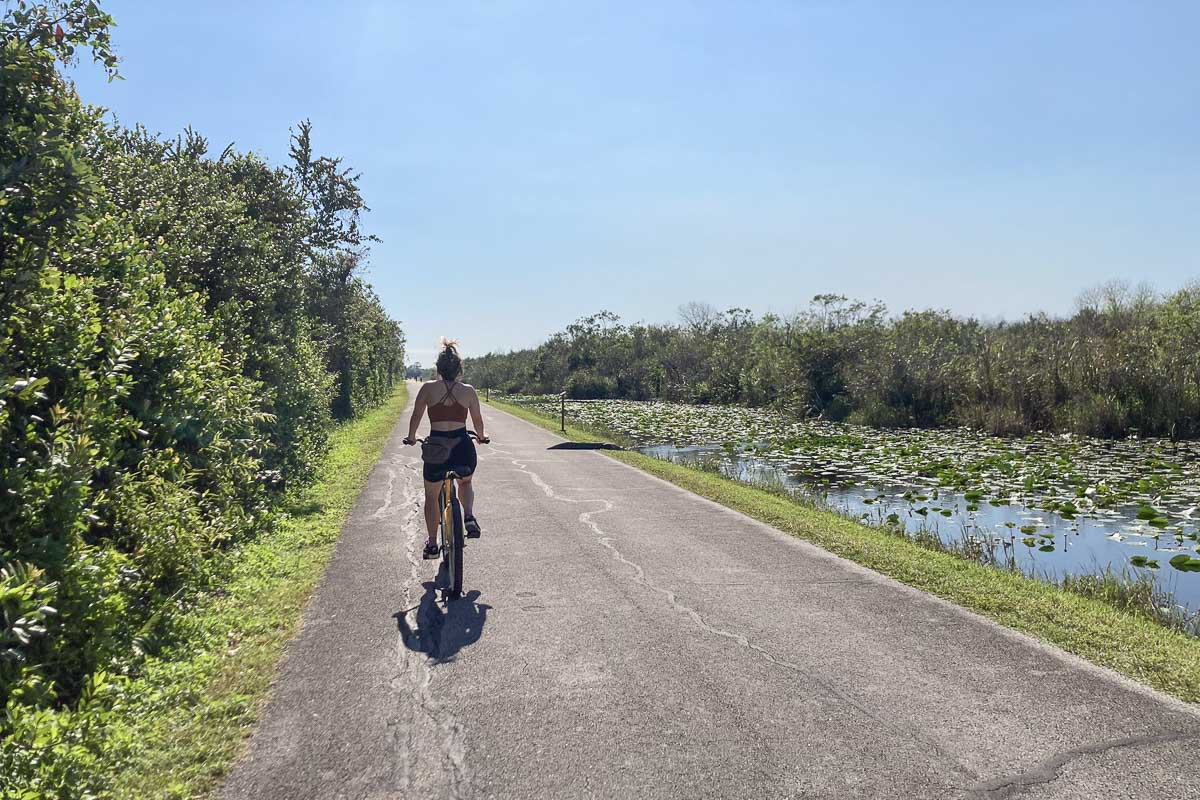
On an Everglades bike tour, you can cover much more distance in a shorter period of time than on foot. This, of course, allows you to see significantly more, too.
And indeed, there are plenty of sights to see while exploring the Everglades by bicycle, from the park’s beautiful and diverse scenery to its mesmerizing abundance of wildlife.
I recommend going on at least one bike ride when visiting Everglades National Park—it offers a completely different perspective on the park—along with a boat tour (an absolute “must”!) and a short hike or two.
Together, boating, hiking, and biking in the Everglades provide you with a well-rounded Everglades National Park experience.
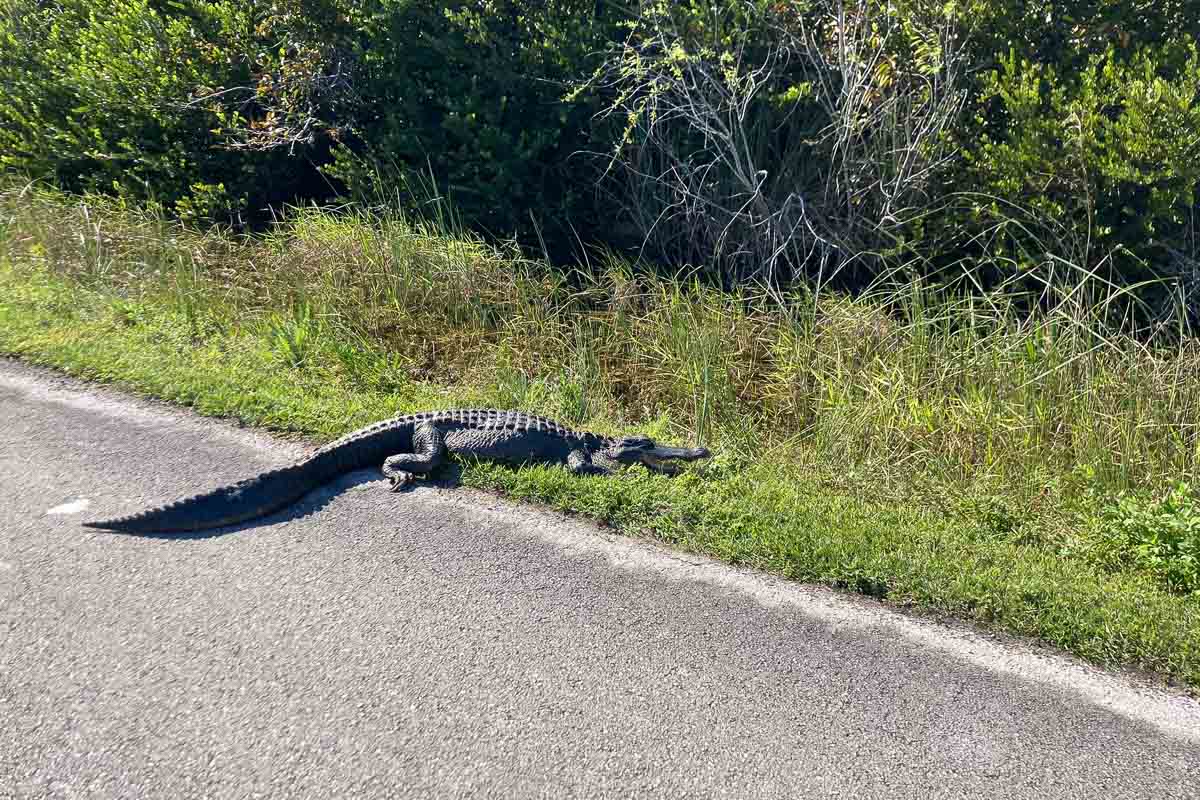
This blog post about biking in Everglades National Park contains affiliate links. You can read more about our Terms of Use / Disclosure here.
Contents
- Biking in Everglades National Park FAQs
- Where Can You Rent Bikes in Everglades National Park?
- Where Are Bikes Allowed in Everglades National Park?
- Are E-bikes Allowed in Everglades National Park?
- Which Wildlife Can You See When Biking in the Everglades?
- Is Biking in the Everglades Safe?
- What Do You Need to Bring on Bike Rides in Everglades National Park?
- More About Everglades National Park
- Top 3 Best Bike Trails in Everglades National Park
- More About Florida’s National Parks
Biking in Everglades National Park FAQs
Before we take a look at the best bike trails in Everglades National Park, let’s first answer a few common questions about biking in the Everglades.
Where Can You Rent Bikes in Everglades National Park?
There are two places that offer bike rentals in Everglades National Park. Both are on opposite sides of the park, but each of them does provide access to arguably the two best bike trails in Everglades National Park.
Everglades Flamingo Bike Rentals
At Flamingo, located on the shore of shallow Florida Bay, you can rent bicycles (along with canoes and kayaks) at the activities booth near the Marina Store.
Bike rentals at Flamingo are available for 2-hour periods, allowing you to explore the amazing greater Flamingo area, including Eco Pond and Snake Bight.
You can find more information about Everglades bike rentals at Flamingo, including availability and rates, on the Flamingo Adventures website.
Everglades Shark Valley Bike Rentals
In Shark Valley, the heart of the “True Everglades”, bike rentals are available at the rental office behind the visitor center. Bicycles can be reserved online in advance, while some are also available on a first-come first-served basis.
Shark Valley bike rentals don’t have a time limit—you can explore this wildlife-rich area as long as you want—but you must be back by 5 pm.
For more information about Shark Valley bike rentals, such as reservations, availability, and prices, visit the Shark Valley Tram Tours website.
Where Are Bikes Allowed in Everglades National Park?
Within Everglades National Park, bicycles are allowed on all public roadways. This includes the popular Main Park Road, which runs between the Ernest F. Coe Visitor Center and Flamingo.
Because of heavy traffic on the park roads, however, visitors are cautioned against biking on them. Although permitted on main roads, bicycling is safer and arguably more enjoyable on the designated bike trails in Everglades National Park.
These are all places where you can go biking in Everglades National Park:
- Main Park Road (between the Ernest F. Coe Visitor Center and Flamingo)
- Long Pine Key Natural Trail (Long Pine Key just west of the Ernest F. Coe Visitor Center)
- Snake Bight Trail (multi-use trail near Flamingo)
- Rowdy Bend Trail (multi-use trail near Flamingo)
- L-67 Canal Road (gravel and grass road about 5 miles east of Shark Valley)
- Shark Valley Tram Road (scenic paved road for hiking, biking and tram tours)
Are E-bikes Allowed in Everglades National Park?
Yes, the National Park Service permits e-bikes in Everglades National Park, with some restrictions.
“E-bikes with fully operable pedals and an electric motor of less than 750 watts (1 horsepower) are permitted on trails and public roads where traditional bicycles are allowed,” the agency says. See the section above for a complete overview of where bikes are permitted within the national park.
The speed limit for electric bicycles in Everglades National Park is 10 mph on all trails and 15 mph on the Shark Valley Tram Road.
However, please note that fully electric bicycles (that don’t require any pedaling) are allowed only on public roads, just like other motorized vehicles.
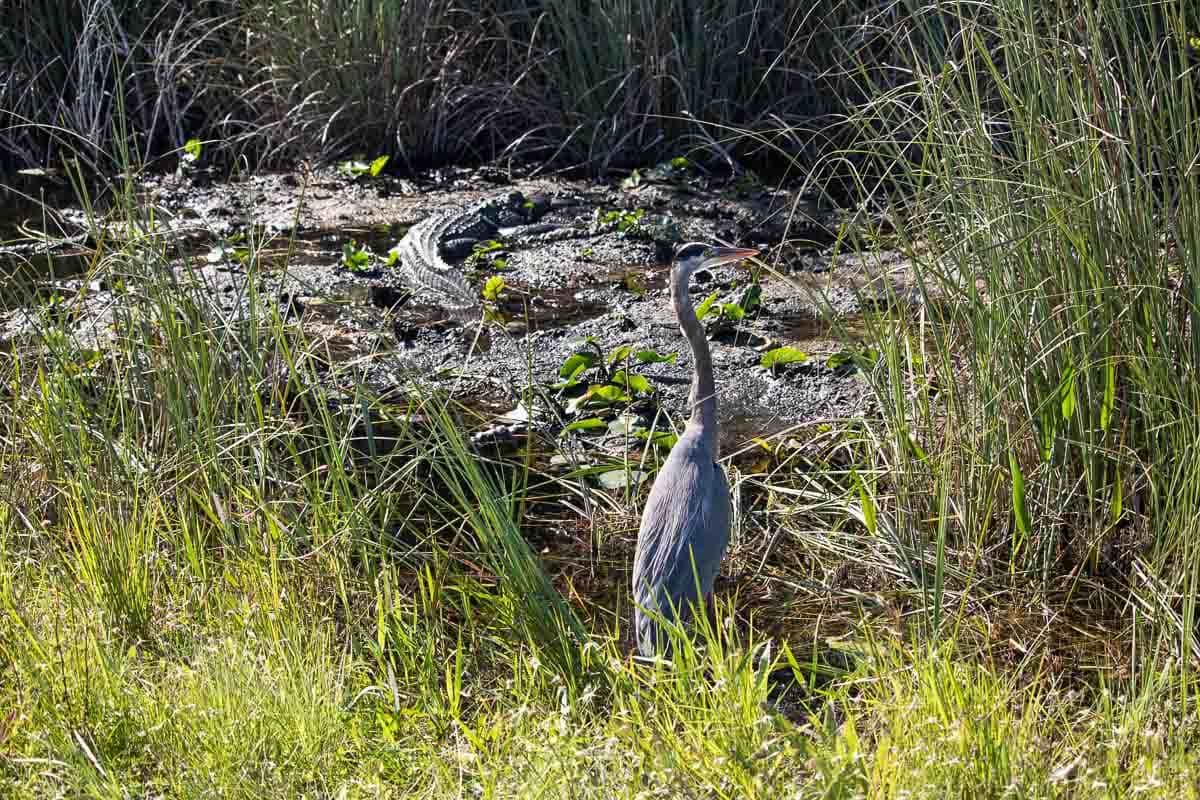
Which Wildlife Can You See When Biking in the Everglades?
Biking is easily one of the best things you can do in Everglades National Park to see wildlife. In fact, besides hiking the famous Anhinga Trail, bike rides are arguably the single best way to spot animals in the Everglades.
I’ve personally had the most success seeing all kinds of Everglades wildlife while biking. On one particular bike ride (see below), I saw no fewer than 91 alligators. That’s not an exaggeration, I actually counted them the whole way.
You can read more about where to see alligators and crocodiles in the Everglades here.
You might also see turtles in trailside ponds, while snakes crossing trails are also not unusual.
Bird sightings are also guaranteed when biking in Everglades National Park. Common sightings include herons, egrets, ibises, anhingas, cormorants, ospreys, vultures, and hawks.
You can read more about the famous birds of the Everglades and where to see them here.
Is Biking in the Everglades Safe?
Absolutely, as long as you don’t approach any wildlife, biking in Everglades National Park is perfectly safe. Even alligators, arguably the most “feared” creature in the Everglades, don’t really pose a significant threat to bikers.
“Alligators and crocodiles have plenty of natural food here and do not seek out humans or pets,” the National Park Service says. They have no reason to attack any cyclists that are just passing by. The agency does warn visitors to not mimic the behavior of potential prey animals, though.
Stay at least 15 to 20 feet from any waterline or animal. And it goes without saying, but don’t feed the wildlife!
In short, wildlife isn’t something to worry about while biking through the Everglades. If anything, the possibility to see alligators and numerous birds in the wild is the very reason why so many people visit the park each year.
That said, however, there are some things to be mindful of on an Everglades bike tour.
First and foremost, it can get quite hot and humid in the subtropical Everglades. It’s essential that you bring lots of water and consider the physical fitness levels of all people in your group.
Shade is hard to find in many places in the park, too, so put on a hat, sunglasses and wear sunscreen.
Additionally, the Everglades is notorious for its mosquitos at certain times of the year, especially in the hot and humid summer season. Therefore, to protect against mosquito bites and potential mosquito-borne diseases, it’s strongly recommended that bikers use insect repellent.
Wearing long sleeves and pants is also a good idea, which offer protection against both mosquitos and sunshine.
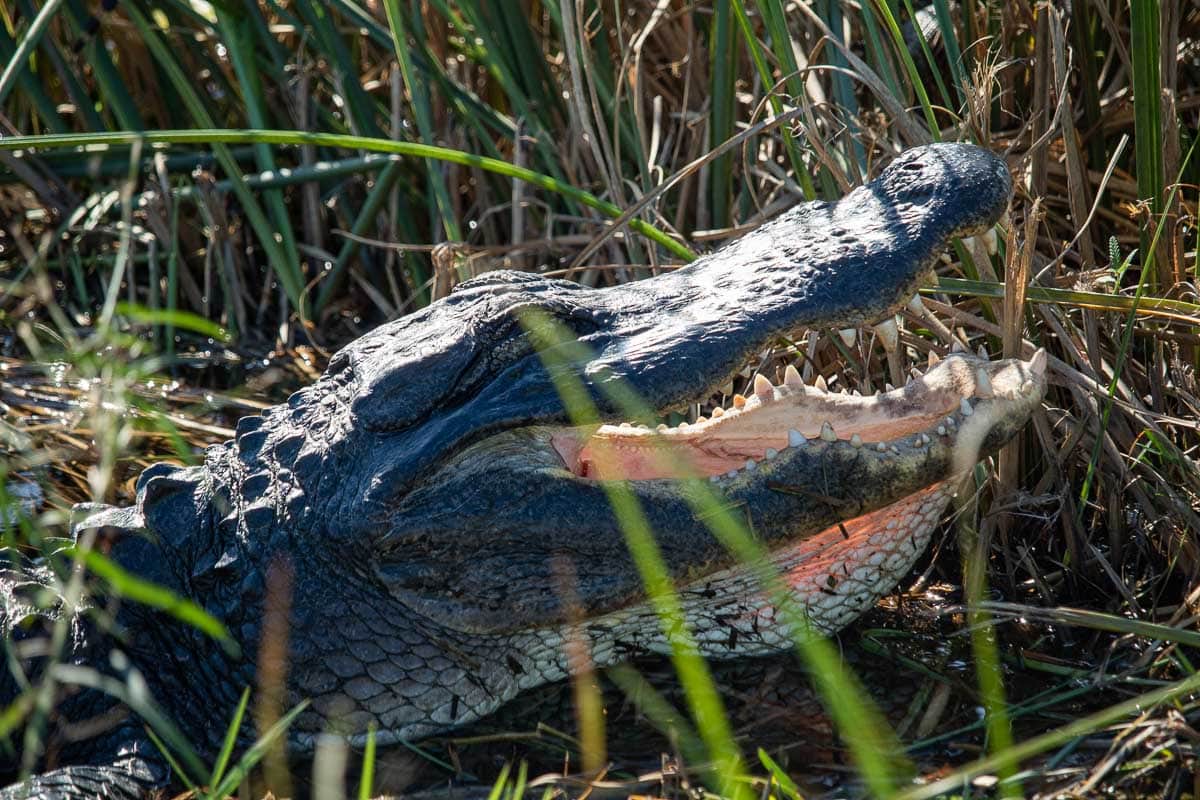
What Do You Need to Bring on Bike Rides in Everglades National Park?
I talked about many of the essential items to bring on an Everglades bike ride in the section about safety above. It doesn’t hurt to repeat those, though, so here’s my list of recommend things to bring on a bike tour in the Everglades.
- Plenty of water for the duration of your bike ride – at least a quart gallon (about 1 liter) of water per hour.
- A hat, sunglasses and sunscreen – to protect against sunburns.
- Insect repellent – because mosquitoes can be really bothersome at certain places and times.
- Long sleeves and pants – for protection against both mosquitoes and sunrays.
- Snacks – there are few places to buy food in the park, so I recommend bringing lots of healthy and salty snacks with you.
- Camera – you’re guaranteed to see wildlife while biking in Everglades National Park.
More About Everglades National Park
- Park Website
- Travel Guide
- Topographic Map
- Where to See Wildlife in Everglades National Park
- Where to See Alligators and Crocodiles in the Everglades
- Famous Birds of the Everglades
- Top Sights on the Everglades Main Park Road
- Accommodation
Top 3 Best Bike Trails in Everglades National Park
If you’re planning on exploring Everglades National Park on two wheels, which I highly recommend, these are the three bike trails worth doing. This is my personal favorite top three of bike rides in the Everglades.
Each of this trio of Everglades bike trails provides a different biking experience, from pedaling through a unique pineland to seeing birds on the shore of Florida Bay and exploring the “River of Grass” itself.
I do have to say, though, that if you only have time for one bike tour in the park, you should absolutely do the Shark Valley bike trail, which is number one on my list below. It is by far the best place in the Everglades to explore by bike.
3. Long Pine Key Natural Trail
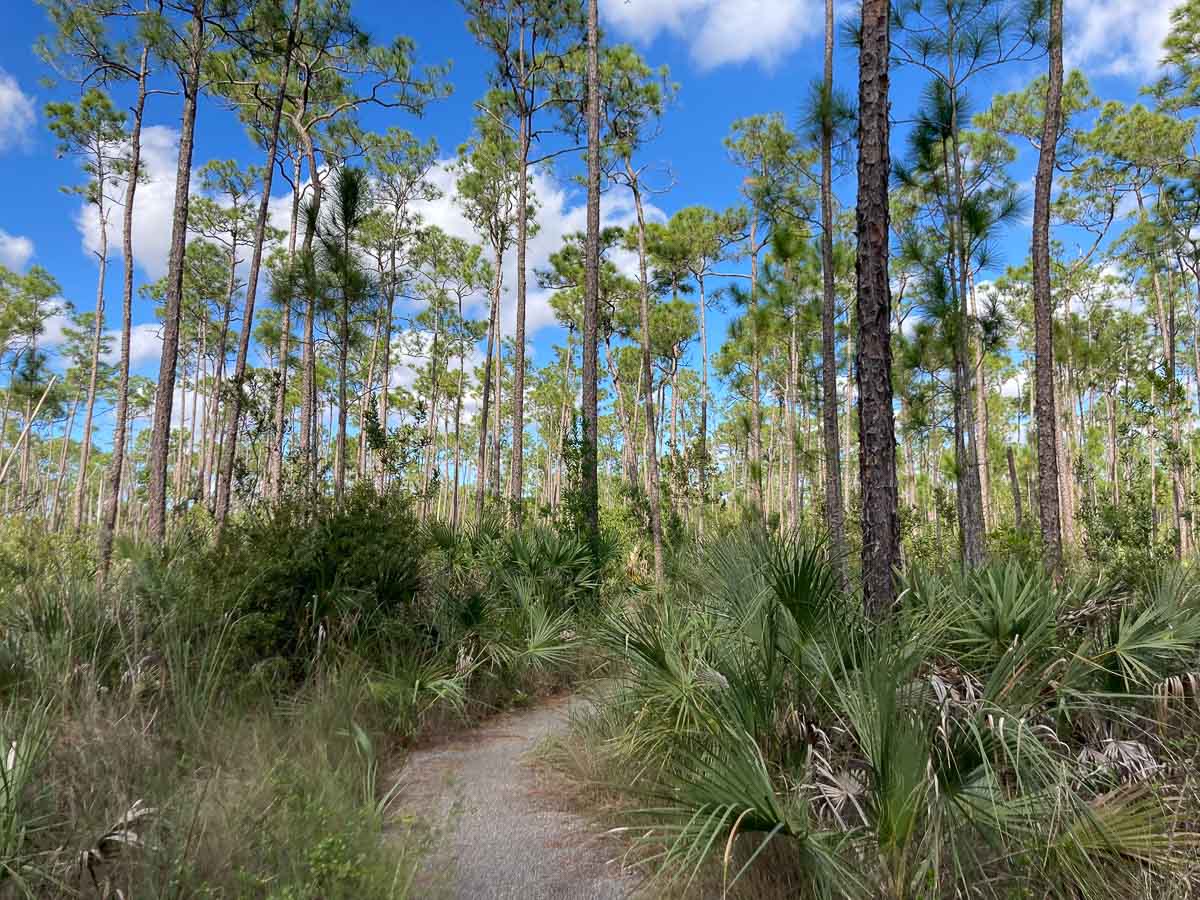
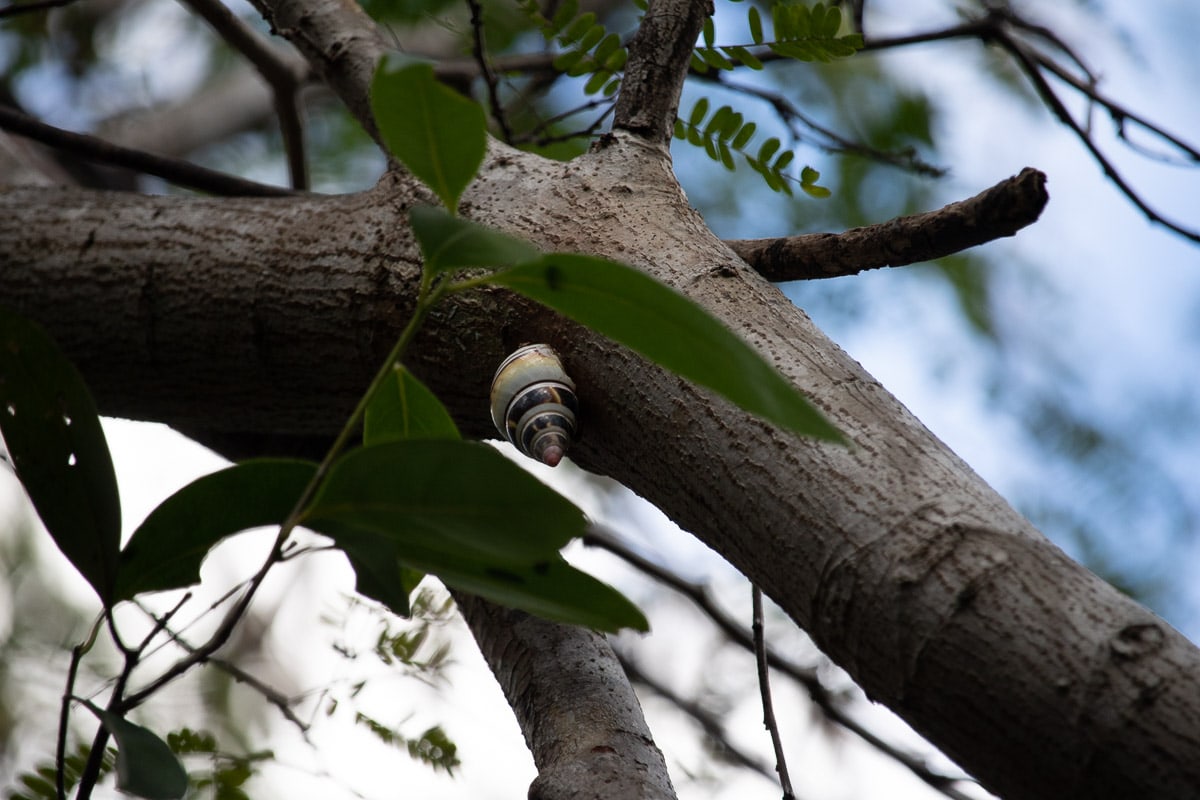
- Location: Long Pine Key Campground
- Distance: 14 miles (roundtrip)
- Duration: 2 hours
- Highlights: unique pineland habitat, diverse plant life, and opportunities to see mammals
A dirt path suitable for both hikers and bikers, the Long Pine Key Natural Trail runs for 7 miles between the Long Pine Key Campground and Pine Glades Lake. The roundtrip bike ride is 14 miles.
Along the way, cyclists get to explore a unique pineland habitat, one of the nine distinct habitats in Everglades National Park. In fact, this is the only so-called “pine rockland” in the national park.
Pineland Habitat
According to the National Park Service, pine rockland is “the rarest and most diverse habitat in the Everglades.” This fire-dependent ecosystem occurs at the park’s highest elevations, along a limestone ridge in South Florida.
Biking the Long Pine Key Natural Trail means pedaling through a remarkable forest of slash pines. The understory is made up of saw palmetto and numerous other plant species, many of which are endemic to the area.
Make sure to look up into the trees, where you might see some Florida tree snails (see the photo above).
Moreover, the Long Pine Key Natural Trail also offers the rare opportunity to see some of Everglades National Park’s mammals.
Look for white-tailed deer and marsh rabbits. And although you’re unlikely to see one, this is arguably the best place in the park to see an endangered Florida panther.
2. Snake Bight – Rowdy Bend Trail Loop
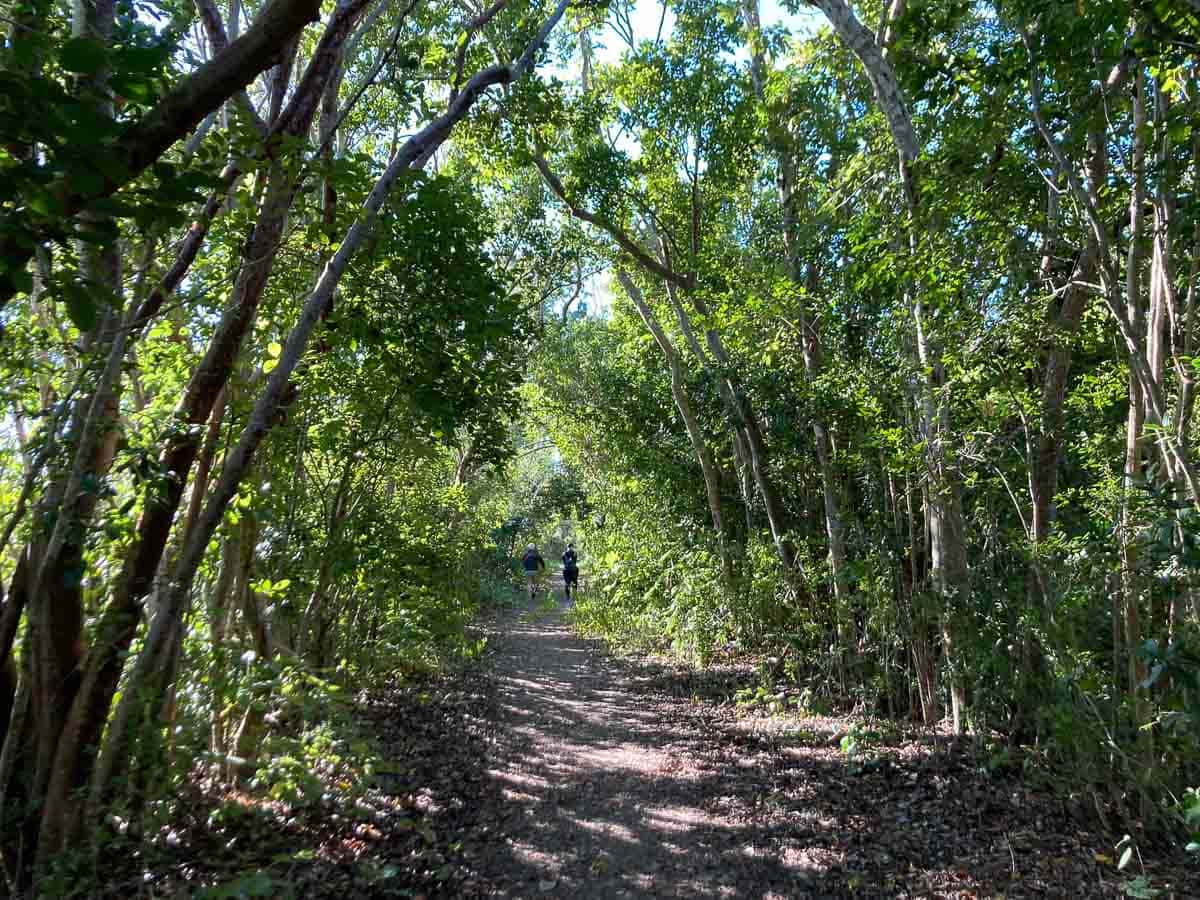
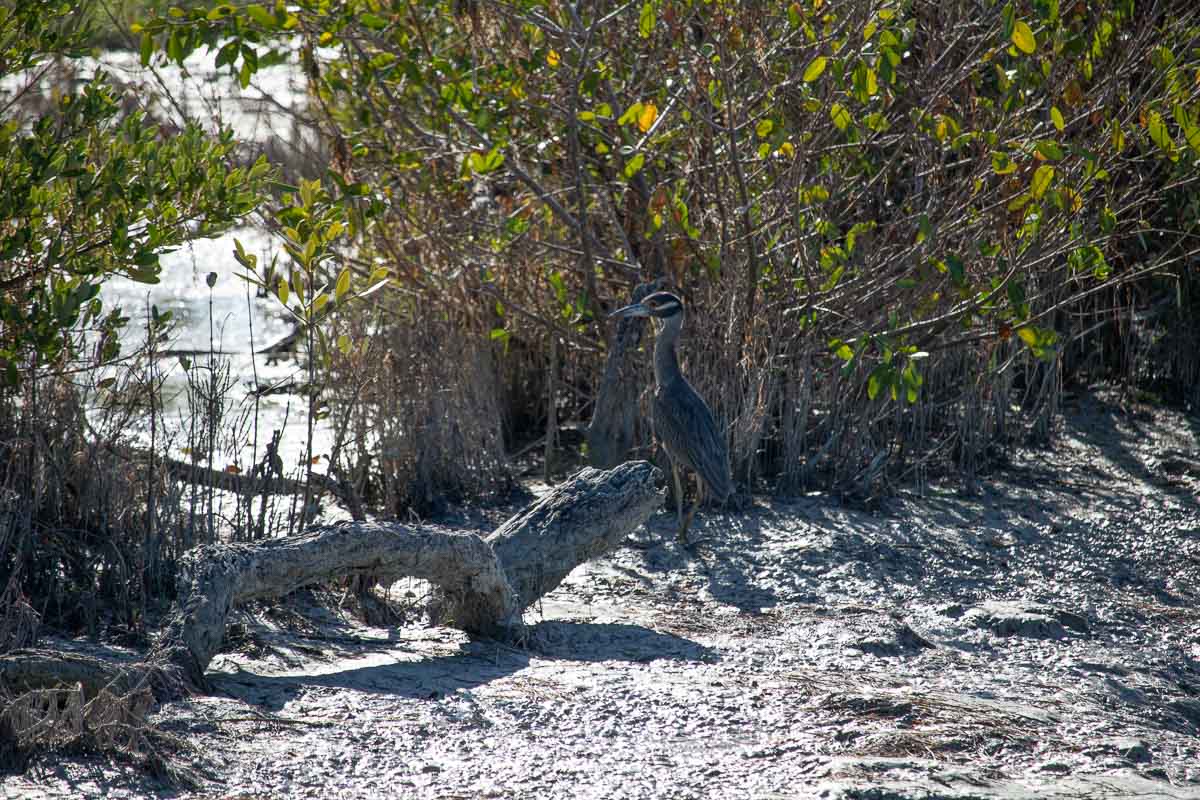
- Location: Flamingo
- Distance: 12.6 miles (roundtrip from the Flamingo Visitor Center)
- Duration: 2 hours
- Highlights: coastal woodland scenery, shore of Snake Bight, occasionally excellent bird watching
Both the Snake Bight Trail and Rowdy Bend Trail are gravel trails just northeast of Flamingo. Their trailheads are on the Main Park Road.
You can bike each trail separately, but why not combine them in a longer loop ride? In fact, you can rent bicycles at Flamingo, pedal a section of the Main Park Road and do this wonderful loop. This roundtrip Everglades bike ride is 12.6 miles total.
Coastal Forest, Prairie and Mangrove Habitat
The Snake Bight Trail is straight as an arrow with zero elevation gain, running from the Main Park Road to a boardwalk viewpoint overlooking Snake Bight.
This is a great area to see some of the park’s woodland birds. On the other hand, the mangrove-lined shores of Snake Bight, which is a smaller bay within Florida Bay, attract an abundance of wading birds at high tide.
Bike back on the Rowdy Bend Trail, which is an overgrown roadbed through open coastal prairie and woodland. This is also an excellent place to see forest birds, such as cuckoos and owls.
I do have to mention, though, that the mosquitoes can be pretty bad in the forest along both of these Everglades bike trails, even during the dry winter season. Don’t forget your insect repellent and consider wearing long sleeves and pants!
Additionally, it’s worth stopping at Mrazek Pond when biking between the Snake Bight and Rowdy Bend trailheads.
Situated along the Main Park Road, this small pond occasionally offers superb bird watching, with huge numbers of wading birds coming in to feast, including wood storks, egrets, and roseate spoonbills. Alligators are sometimes also seen here.
Retrace your route back to Flamingo, keeping your eyes peeled for more wildlife activity on the roadsides and in the surrounding trees.
1. Shark Valley Tram Road
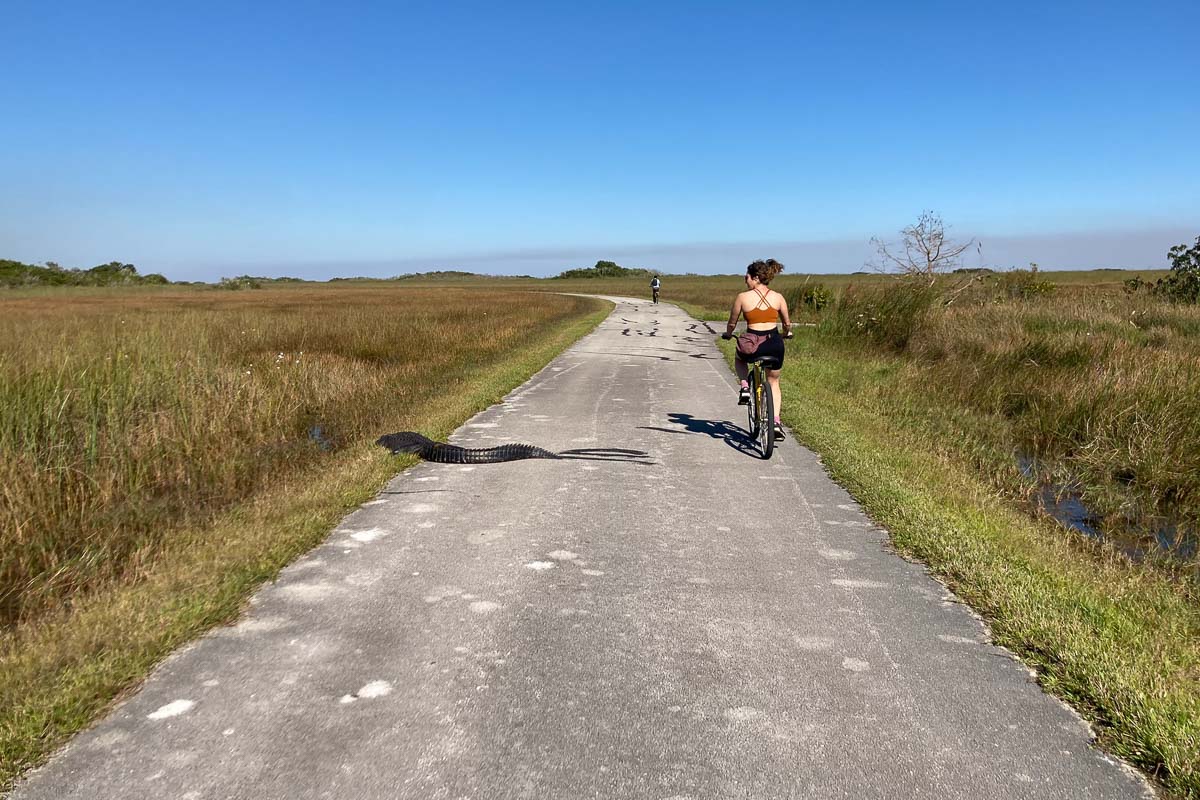
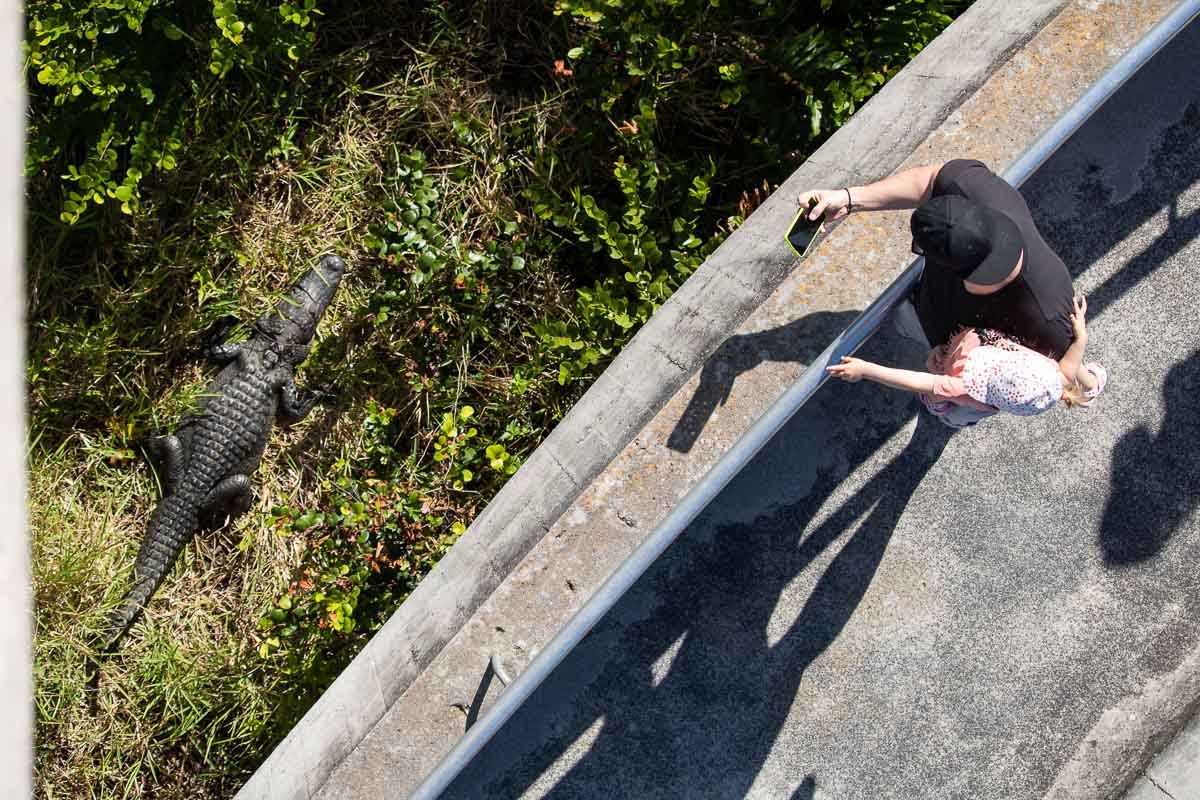
- Location: Shark Valley
- Distance: 15 miles (loop)
- Duration: 3 hours
- Highlights: iconic Everglades wetland landscapes, unparalleled opportunities to see alligators and other reptiles, excellent bird watching, Shark Valley Observation Tower
If there’s one Everglades bike trail you simply have to do, it’s the Shark Valley bike trail. Following the paved Shark Valley Tram Road, this is an absolutely phenomenal bike ride.
It’s one of the best bike trails in Florida and probably even in the entire National Park System.
After picking up your Shark Valley bike rental, you’ll follow the straight West Road all the way to the Shark Valley Observation Tower, the halfway point of this easy yet unforgettable Everglades cycling adventure.
The Shark Valley Observation Tower is the highest point accessible on foot in Everglades National Park. (You can’t bike up the tower, but there are bike racks available.)
Needless to say, the views from the top are spectacular, taking in the freshwater Shark River Slough and the iconic “River of Grass.” What I do have to say, though, is that you should also look directly down from the top. There may be one or more alligators lounging right underneath the tower.
Sawgrass Marsh Habitat
The return ride is a meandering pedal past ponds and through wetlands, with some patches of trees in between. Biking Shark Valley is a 15-mile loop ride.
While the views are sensational here, the undisputed top attraction of the Shark Valley bike trail is the wildlife. Alligators abound here and you’re guaranteed to see several. On my own bike ride in Shark Valley, I saw 91 alligators!
Additionally, also watch for turtles in the ponds and canals, as well as snakes along the road. Birds also thrive in Shark Valley, including herons, egrets, anhingas, and snail kites.
This is easily one of the best places to see wildlife in Everglades National Park.
Lastly, because you’ll share the Shark Valley Tram Road with hikers, other bikers, the actual tram, and lots of animals, be cautious when biking. You’re supposed to stop and let the tram pass, while you must stay at least 15 to 20 feet from all wildlife.
